Sorry for the delay guys, way too much going on around here.
The mod went fine, but the results really were a mixed bag. First thing is its a hot chip and it responds really well to lower temps, but no so much increased voltage.
Here is what the card looked like with the EVGA block removed, lots of white silicone, with pretty bad contact on the memory chips. I re-set the block with AS Ceramique to check contact and it was better with a little more paste and more torque on the block. Nylon spacers are used between the block and the PCB.
The finish on the block was so-so, the machine work was a little rough but all that buffing costs money I guess. I pulled the block apart to clean the leftovers from tapping the inlet/outlet holes for fittings.
I'm sure you've all seen EVGA's take on cooling, the logo is pretty neat and it seems to work pretty well, but seeing how I was already in there I figured I'd break out the dremel and create a little more surface area. I didn't go that deep as it is not that thick to start with. Flame on if you want, I couldn't think of how this would be detrimental, should at least create more turbulence through the "pin" array.
The mod was refreshingly simple, with nothing really to burn up. I used to mount the pots legs directly to the solder point, but if the card is going to be moved around a lot, I have found the small wires give a little more without damaging the board.
I actually forgot to install a vGPU check line before bolting the block up so I had to do this while the block was in place, otherwise I would have used a point closer to the outer edge of the board.
While I had the block off I polished all the visable surfaces, and hit the ram and cpu seating surface lightly, which took off some edges you could feel with yoru fingernail. Its pretty sharp all polished.
Results:
Using chilled water (water temp is maintained around 60F with a 5000btu Daewoo AC) the card responded well. Idle temps were 20C while loaded temps were 28-31C.
I found there is an issue with clocking the card past the high 700s and 800s range using Riva/Precision. You can get past this by using Nibitor, but your core clock will be reported as 100mhz in Riva/Precision. Also, as I have never loved Nvidia's dynamic clock switching (anyone remember the 7900 not switching?) I set all the clocks and VID the same in the bios. This caused a rather nasty corrupt screen when loading windows so I flashed it back, clock switching will stay I guess.
I was able to run 826 core 1620 shader and a pretty impressive 2754 on the memory. I was able to run 2800 on memory for benchmarks, but it showed some errors in ATITool. 1674 shader was not doable at any voltage. Also, forcing different shader clocks in the bios has mixed results, as does forcing odd clock frequencies. Setting core to 794 and shader to 1512 would cause instant hard-lock in ATITool, setting core to 794 and shader to 1566 was stable. Setting core to 795 would instant hard-lock. All clock changes had to be made with bios as Riva/ATItool would not set clocks above 783 core.
As far as voltage goes, anything over 1.350v caused it to pop pixels in ATItool constantly. Even with loaded temps in the low 30s. The card was bench-stable/game-stable at these speeds with the chilled water, but was not stable once loaded temps passed 45-47C (with the chiller off). Voltage was at 1.338 for tests.
The card belongs to a friend was visiting, so we didn't have a ton of time to test it. Its going in a system with a QX 9650 and I'll post up some benchmarks once he gets it running in that system.
Here is a 3DMark06 run on my Q6600:













 Reply With Quote
Reply With Quote






 Currently i'm waiting for a Koolance waterblock along with a Exos 2-LS to see if I can push my card anymore for stable gaming use. I have a DD Tieton on a Koolance Exos 1 running 1/4 in tubing so I imagine the results will improve with the new block (thinking the backplate and actual block quality will help) and Exos 2-LS. Right now load temps hit 63c and I still manage clocks of 756/1512/2650 rock solid stable. I'm hoping to be able to raise the shaders higher as 1600 is stable till it heats up past 50c like you mentioned. This would allow me to go for 800/1600/2700 however I'm not sure, esp with no voltage adj.
Currently i'm waiting for a Koolance waterblock along with a Exos 2-LS to see if I can push my card anymore for stable gaming use. I have a DD Tieton on a Koolance Exos 1 running 1/4 in tubing so I imagine the results will improve with the new block (thinking the backplate and actual block quality will help) and Exos 2-LS. Right now load temps hit 63c and I still manage clocks of 756/1512/2650 rock solid stable. I'm hoping to be able to raise the shaders higher as 1600 is stable till it heats up past 50c like you mentioned. This would allow me to go for 800/1600/2700 however I'm not sure, esp with no voltage adj.
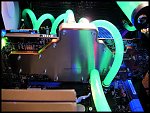
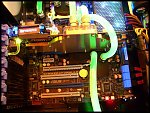
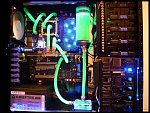
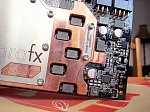
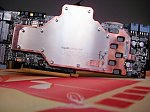

 Intel i9 7900X @ 4.6GHz @ 1.126v
Intel i9 7900X @ 4.6GHz @ 1.126v  ASUS X299 TUF MARK 1
ASUS X299 TUF MARK 1  32GB G.Skill DDR4 2800
32GB G.Skill DDR4 2800  2x ZOTAC AMP EXTREME Core GTX1080Ti's in SLi
2x ZOTAC AMP EXTREME Core GTX1080Ti's in SLi  Loop 1: Apogee GTZ CPU block, MCR360 rad w/ Scythe fans, Micro-res, Aquaextreme 50Z pump
Loop 1: Apogee GTZ CPU block, MCR360 rad w/ Scythe fans, Micro-res, Aquaextreme 50Z pump  U2-UFO case
U2-UFO case 



Bookmarks